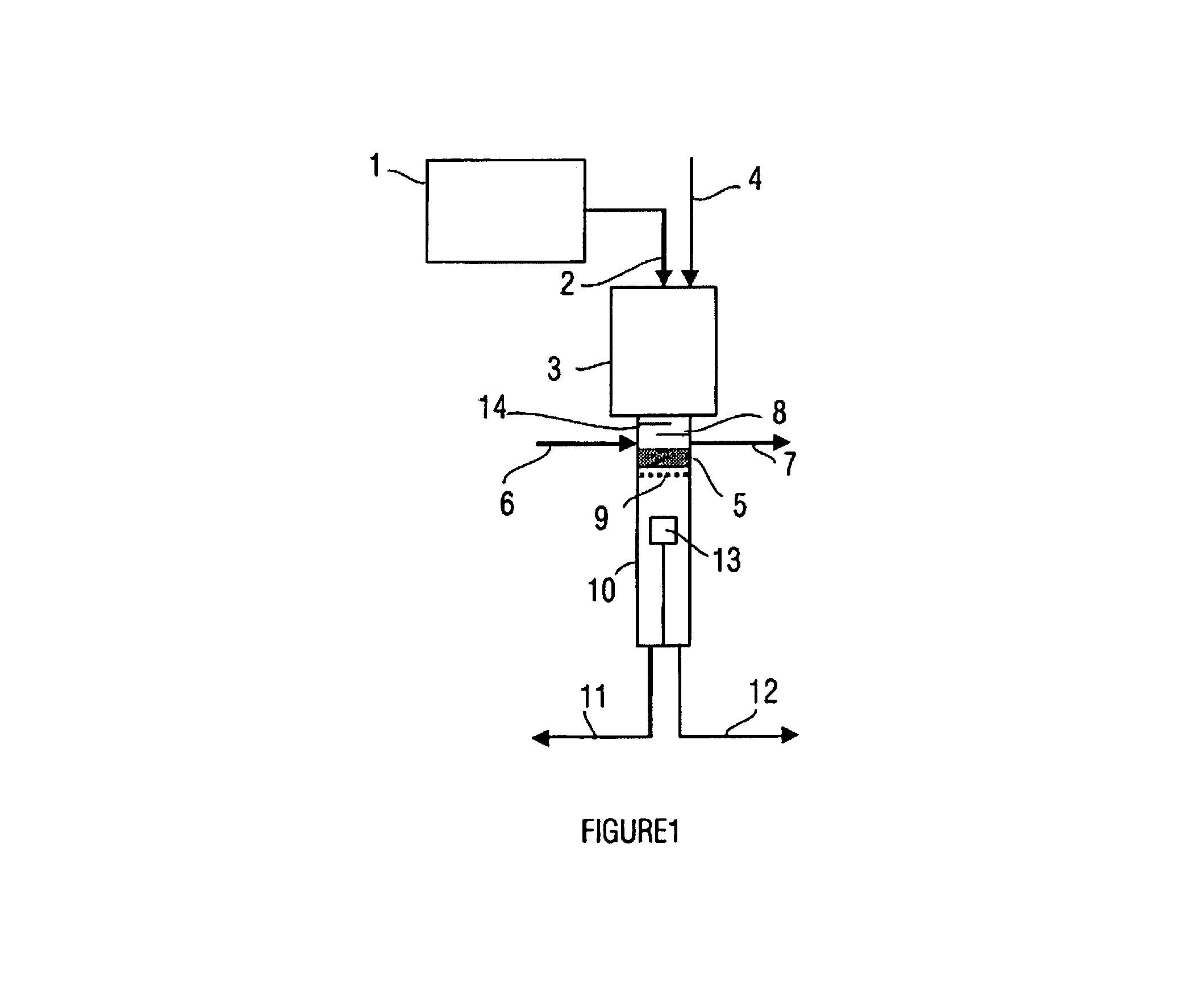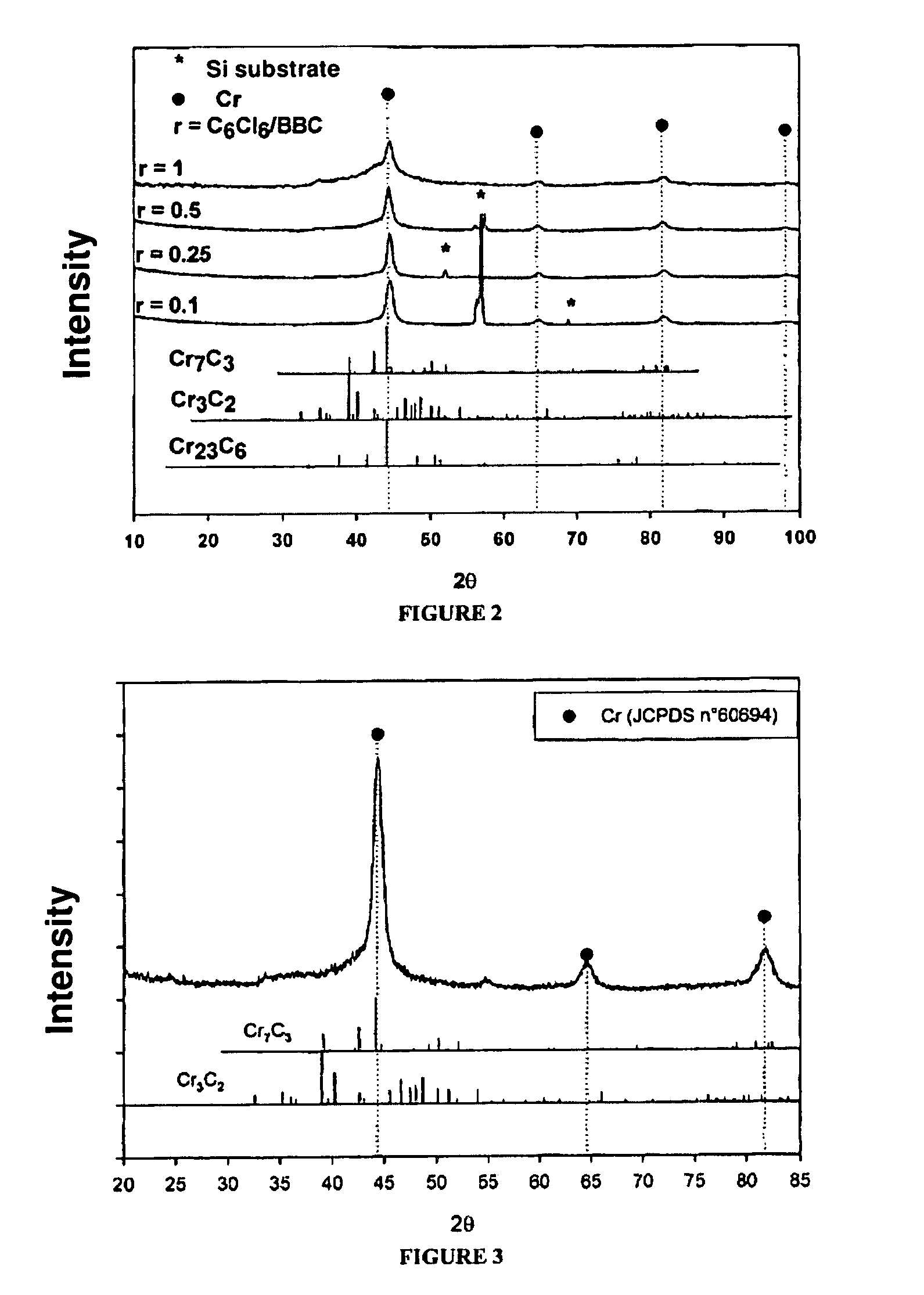Method for depositing hard metallic coatings
a technology of hard metallic coatings and coatings, applied in the field of surface treatment, can solve the problems of poor adhesion, low hardness value, and chromium coatings are often amorphous, and achieve the effect of removing these drawbacks
- Summary
- Abstract
- Description
- Claims
- Application Information
AI Technical Summary
Benefits of technology
Problems solved by technology
Method used
Image
Examples
example 1
DLI-MOCVD Deposition Device
[0057]The DLI-MOCVD device that is used for the deposition of metal layers, which will be described in detail later, consists primarily of a vertical, cold-wall CVD reactor linked to a commercial pulsed injection system. It makes it possible to obtain monolayer metal coatings as well as nanostructured multilayer stacks of these same coatings.
[0058]In the configuration where it is shown in FIG. 1, it comprises in a central manner an evaporator 3 that empties into a deposition chamber 10 that consists of a vertical cold-wall CVD reactor. A pressurized storage tank 1 for the precursor solution at ambient temperature supplies an injector 2 whose opening toward the evaporator 3 is computer-monitored. A modified diesel automobile injector is conventionally used. A line for feeding vector gas 4 enters the nose of injector 2. A stop valve 5 makes it possible to insulate the evaporator 3 from the deposition chamber 10. The tap 6 above the stop valve 5 makes possibl...
example 2
Obtaining Chromium Metal Coatings from a BBC and C6Cl6 Solution in Toluene
[0060]The Precursor Solutions
[0061]The bisarene-type organometallic chromium precursor: Cr(C6H6)2 or BBC, dissolved in degassed toluene and dehydrated on silica gel, is used. The decomposition temperature of the BBC is 350° C. Whereby the saturation concentration of the BBC in toluene determined by UV-Vis spectrophotometry is 5.1·10−2M, a solution with a lower concentration (here, equal to 3.10−2 mol / l) is prepared to avoid any re-precipitation of the precursor that would run the risk of plugging the injector of the DLI system.
[0062]The chlorinated additive is C6Cl6. Purification by recrystallization can be considered to avoid any contamination with oxygen. Four solutions are prepared with a different C6Cl6 / BBC molar ratio (see table on the following page).
[0063]The solution, pressurized at 2.5 bar (relative), is injected at a rate of 1.4 ml / minute at a frequency of 10 Hz and an opening time of 0.5 ms in the e...
example 3
Obtaining Chromium Metal Coatings from a BBC and C6Cl6 Solution in Cyclohexane
[0073]The composition of the injectable solution is as follows. The chromium precursor is BBC and the chlorinated additive is hexachlorobenzene C6Cl6. They are used in a molar ratio r=0.1 in solution in cyclohexane, at a rate of 1.4·10−2 mol / l for the BBC and 1.4·10−3 mol / l for C6Cl6. The deposition procedure that is applied here is the same as that of Example 2.
[0074]A dull gray deposit is obtained, whereas with the toluene solvent, for the same coating thicknesses, the chromium deposit is a gray-metallic mirror deposit. This is due to a nodular surface morphology, responsible for a high level of surface roughness. In section, the layer first consists of a dense-surface structure, then a nodular structure measuring several hundred nanometers.
[0075]X-Ray diffraction analyses have been carried out. FIG. 3 presents the diagram that is obtained for a deposition on Si, compared to the stable carbide diagrams l...
PUM
| Property | Measurement | Unit |
|---|---|---|
| temperature | aaaaa | aaaaa |
| temperature | aaaaa | aaaaa |
| decomposition temperature | aaaaa | aaaaa |
Abstract
Description
Claims
Application Information
 Login to View More
Login to View More - R&D
- Intellectual Property
- Life Sciences
- Materials
- Tech Scout
- Unparalleled Data Quality
- Higher Quality Content
- 60% Fewer Hallucinations
Browse by: Latest US Patents, China's latest patents, Technical Efficacy Thesaurus, Application Domain, Technology Topic, Popular Technical Reports.
© 2025 PatSnap. All rights reserved.Legal|Privacy policy|Modern Slavery Act Transparency Statement|Sitemap|About US| Contact US: help@patsnap.com



